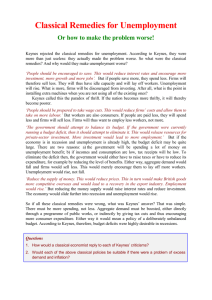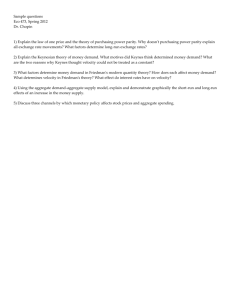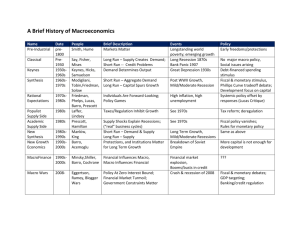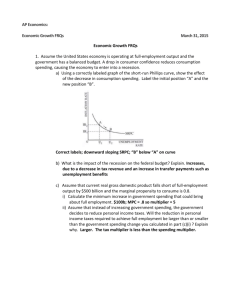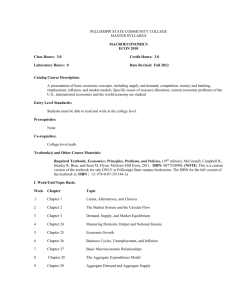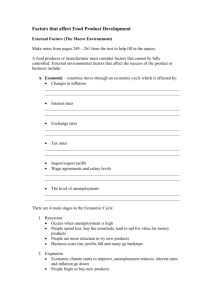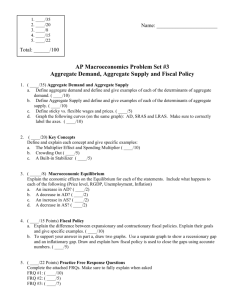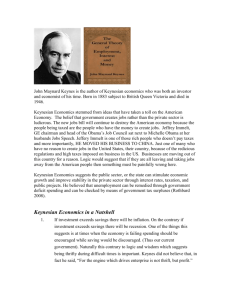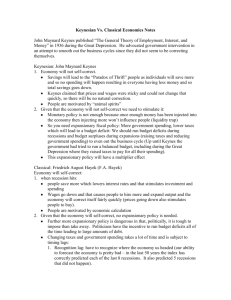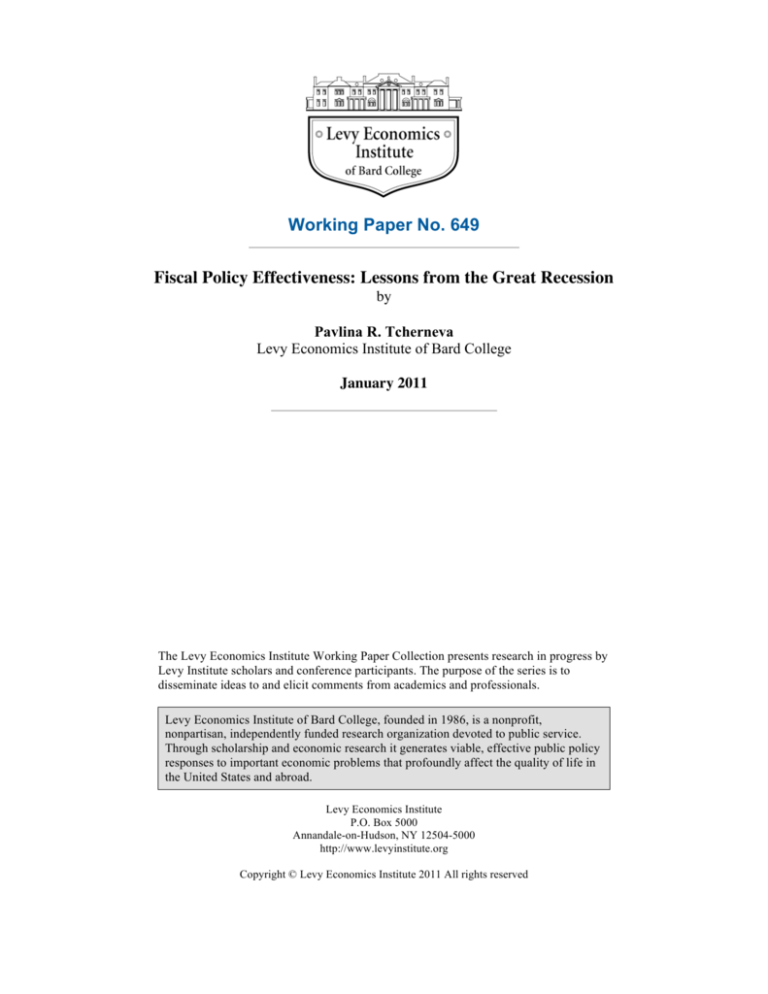
Working Paper No. 649
Fiscal Policy Effectiveness: Lessons from the Great Recession
by
Pavlina R. Tcherneva
Levy Economics Institute of Bard College
January 2011
The Levy Economics Institute Working Paper Collection presents research in progress by
Levy Institute scholars and conference participants. The purpose of the series is to
disseminate ideas to and elicit comments from academics and professionals.
Levy Economics Institute of Bard College, founded in 1986, is a nonprofit,
nonpartisan, independently funded research organization devoted to public service.
Through scholarship and economic research it generates viable, effective public policy
responses to important economic problems that profoundly affect the quality of life in
the United States and abroad.
Levy Economics Institute
P.O. Box 5000
Annandale-on-Hudson, NY 12504-5000
http://www.levyinstitute.org
Copyright © Levy Economics Institute 2011 All rights reserved
ABSTRACT
This paper reconsiders fiscal policy effectiveness in light of the recent economic crisis. It
examines the fiscal policy approach advocated by the economics profession today and the
specific policy actions undertaken by the Bush and Obama administrations. An
examination of the labor market renders the contemporary aggregate demand–
management approach wholly inadequate for achieving certain macroeconomic
objectives, such as the stabilization of investment and investor expectations, the
generation and maintenance of full employment, and the equitable distribution of
incomes. The paper reconsiders the policy effectiveness of alternative fiscal policy
approaches, and argues that a policy that directly targets the labor demand gap (as
opposed to the output gap) is far more effective in stabilizing employment, incomes,
investment, and balance sheets.
Keywords: The Great Recession; Fiscal Policy; Macroeconomic Stabilization;
Employment
JEL Classifications: E24, E25, E65, J08, J6
INTRODUCTION
To many economists the swift and unequivocal support of the profession for fiscal activism
during the Great Recession has been somewhat of a surprise. After all, since the late 1970s, most
mainstream economists had completely abandoned faith in fiscal policy effectiveness, largely
because of the empirically dubious Ricardian Equivalence Hypothesis (see Barro 1974).
Nevertheless, here we are, more than two years after the global financial meltdown of September
2008, in a position to reconsider the role and place of fiscal policy in stabilizing a devastated
economy.
The economist who provided the raison d'être for countercyclical fiscal policy was John
Maynard Keynes, whose revolutionary theory (1964 [1936]) transformed the way we understand
the functioning of the economy. In reassessing the proper role of fiscal policy today, it should be
remembered that Keynes inextricably linked the goal of macroeconomic stabilization to the goal
of full employment. He had a very narrow definition of full employment and argued that
policymakers had a responsibility to ensure that “everything that could humanly be done has
been done by the state … [to produce] a reduction of the unemployed to the sort of levels we are
experiencing in wartime…that is to say, an unemployed level of less than 1 per cent
unemployed” (Keynes 1980: 303). This is the definition of full employment that will be used in
this paper and I shall argue that achieving and maintaining this level, while simultaneously
stabilizing the business cycle, is possible if we carefully heed the Keynesian message.
The principle objective of fiscal policy according to Keynes was to solve “the real
problem, fundamental yet essentially simple… [namely] to provide employment for everyone”
(Keynes 1980: 267). This objective was nevertheless gradually abandoned by the political
process and much of academic economic analysis. Instead, the goal of modern fiscal policy has
largely been confined to stabilizing incomes, consumption, and investment, whereas employment
stabilization is left to be determined as a byproduct of these policies. Keynes, by contrast,
believed that the unemployment problem should be solved speedily and directly by one primary
method—direct job creation through public works.
This paper argues that the original Keynesian message can provide both a crucial tool for
dealing with the Great Recession and a policy for addressing the unemployment problem at all
phases of the business cycle. In particular, it makes the case that conventional aggregate demand
2
management policies are inadequate for dealing with the unemployment problem during
recessions and incapable of achieving true full employment in expansions. The paper will
examine the kinds of fiscal responses that are generally favored by modern economists and
policymakers today, as well as the specific policy actions that were undertaken in the United
States to deal with Great Recession after the September 2008 financial meltdown. Next, it will
overview briefly the labor market conditions in the United States to underscore the inadequacy of
the current response. Finally, it will raise and answer the question “what is to be done?” While
there are good reasons to believe that the fiscal push was too small, this paper will argue that
aggregate demand management cannot establish what Keynes called “a closer approximation of
full employment as nearly as is practicable” (Keynes 1964 [1936]: 378–79). Instead, it suggests
that what is required is a fundamental reorientation of fiscal policy from one that attempts to
close the output gap to one that aims to close the labor demand gap. This approach circumvents a
series of shortcomings associated with the aggregate demand management approach. It is a direct
approach that delivers macroeconomic stability and addresses the problems of urban blight and
rural poverty with its strong regional emphasis. It is a policy that solves the unemployment
problem over the long run because it specifically tackles its cyclical, structural, and seasonal
components, as well as the problems of the long-term unemployed, the unemployable, the
working poor, and the new entrants in the labor market.
MODERN FISCAL POLICY AND THE GREAT RECESSION
The Conventional View
Most contemporary economists use the “leaky bucket” analogy to explain how fiscal policy
works. Government increases spending for the purposes of boosting GDP growth sufficiently to
reduce unemployment to desired levels. Because the fiscal stimulus enters the economy through
a leaky bucket (e.g., some of it is lost in transit because of administrative costs and some of it,
such as tax cuts and certain investment subsidies, has no direct job-creation effect), not all of the
money reaches the poor and unemployed. This leaky-bucket analogy comes from the work of
Arthur M. Okun, the economist who inspired the economic “law” that motivates this policy
approach. Okun’s Law states that a 1 percent increase in unemployment would generate an
approximate 3 percent decline in GDP growth. This relationship has been flipped and used as a
3
policy guide that lends support to broad-based, pro-growth policies. The law indicates that
unemployment can be reduced if the government manages to stimulate growth at a fast enough
rate. Note that 3 percent growth in actual GDP (relative to potential output) brings about only a 1
percent reduction in unemployment—a rather small and unimpressive effect (Okun [1962]
himself cautioned that the GDP-to-unemployment relationship is rather weak). Although
economists generally accept the inverse relationship between growth and unemployment, the
exact empirical form of this relationship has received widespread criticism (Altig, Fitzgerald, and
Rupert 1997; Lee 2000). From a policy perspective the law does not provide a good guide for
government action, even though it motivates the aggregate demand approach. This is because it
is unclear what rate or type of growth is required to produce sizeable reductions in
unemployment, much less anything close to genuine full employment.
Fiscal Policy during the Great Recession
Despite the small employment effect stipulated by Okun’s law, the general agreement across the
theoretical spectrum is that boosting aggregate demand is the proper objective. There is some
disagreement on the exact method by which aggregate demand can be expanded, but generally
the policy response would include an automatic and a discretionary component. Government
spending expands automatically in recessions with the increase in unemployment insurance,
welfare benefits, and other transfers to the jobless and the poor. In addition, tax revenues decline
with the fall in economic activity, thus boosting the countercyclical government deficit.
Furthermore, a number of discretionary moves can be undertaken to hasten the recovery. These
normally include additional tax cuts to households and businesses, as well as direct aid to states
and firms in the form of grants, contracts, and loans for the purposes of new investment.
The policy response from the G.W. Bush and Obama presidencies in the aftermath of the
September 2008 financial crisis followed the general recipe outlined above. It also included a
few additional government expenditures, which are not commonly used as countercyclical
stabilization measures. The first large injection of government spending took place under G.W.
Bush for the purposes of purchasing a large number of nonperforming financial assets from the
balance sheets of ailing banks. Although these purchases were executed by the Federal Reserve,
they constitute fiscal policy because the Fed cannot purchase private sector liabilities from bank
portfolios without congressional authority. In essence, it is the Treasury with the assistance of the
4
Fed that bought a large number of financial assets from private banks. For the purpose, Congress
provided the Fed with a budget of $700 billion to execute the purchases of asset-backed
securities, agency paper, and other assets under the first Troubled Asset Relief Program (TARP).
The TARP also facilitated a massive infusion of funds into General Motors and Citigroup and
the virtual nationalization of the insurance giant AIG. The objective was to stabilize bank
balance sheets to get credit flowing again for the purposes of financing investment.
Whereas fiscal policy was initially used in order to buy nonperforming financial assets
from mostly private financial institutions (and to replace them with default-risk-free government
assets, namely reserves), it is more frequently used to purchase real goods and services from
firms and provide direct income assistance to households and states. Thus the second part of the
fiscal stabilization plan was President Obama’s American Recovery and Reinvestment Act of
February 2009 (ARRA), which appropriated an additional $787 billion that included $288 billion
in tax cuts and benefits to individuals and firms; $275 billion in contracts, grants, and loans; and
$224 billion in entitlements. Among the latter, the White House enacted the longest-lasting
emergency unemployment program in history that included the first benefit increase in a
downturn in history (National Economic Council 2010: 25). Furthermore, it supplemented the
Temporary Assistance to Needy Families (TANF) program with emergency funds, which quietly
expired by the end of 2010.
While the budgets for TARP and ARRA alone constituted approximately 10 percent of
GDP, they remained inadequate in size and direction, as their net effect on GDP growth or
employment was small (Baker 2009). Firstly, as the federal government increased its spending,
states, households, and firms continued slashing theirs, offsetting much of the effect. Secondly,
these types of injections did not all boost output, as much of the fiscal stimulus (the TARP
program in particular) generated demand for non-reproducible financial assets (or what Hahn
[1977: 39] called “non-employment inducing demand”). In addition, some of the tax cut
payments received by firms and households were used for the purposes of deleveraging. Finally,
in the cases when government demand did increase output and production, it did not deliver the
employment creation effect that policymakers aimed for. This is largely due to the kind of
restructuring that takes place in recessions, which results in a production process that relies on a
leaner labor force and low labor costs.
5
The Unemployment Situation in the United States
The misplaced faith in pump priming policies is evident in the dismal employment results the
Bush and Obama stabilization packages produced. Upon taking office, president Obama pledged
to create or save three to four million jobs. The ARRA specifically intended to prevent
significant increases in the unemployment rate and launch a strong jobs recovery. Nevertheless,
the White House’s projections turned out to be woefully inadequate. The Romer-Bernstein report
(2009), which lent support to the ARRA program, estimated that without the stimulus package
the unemployment rate would have reached as high as 9 percent, but with a strong fiscal push, it
would peak around 8 percent and would quickly turn around. In reality, unemployment peaked at
10 percent after the ARRA was passed and has been hovering around 9.6 percent for over a year
and a half with no decline in sight (figure 1).
Figure 1: Unemployment Rate
More troublesome is the fact that whatever stabilization we have observed in the
unemployment rate is largely due to the mass exodus of discouraged workers from the labor
market. The labor force participation rate has been on the longest running decline for the first
time in postwar history and the employment population ratio has collapsed to 58 percent—levels
not seen in three decades (figure 2).
6
Figure 2: Labor Force Participation Rate and Employment-to-Population Ratio
Simultaneously, the labor market is witnessing the wholesale destruction of full-time jobs
(figure 3) and record levels of long-term unemployment (figure 4). This latter statistic is
particularly disconcerting because the long-term unemployment rate has been on a secular
uptrend for the last four decades whereas short-term unemployment has been on a steady decline
throughout the entire postwar period. Figure 4 shows the number of people who have been
unemployed for 15 weeks or longer as a percentage of total unemployment, as well as those who
have been without a job for 27 weeks or more (a subset of the first group). While the series are
highly cyclical, their trends have been decidedly up for the last four decades—in every
subsequent expansion the long-term unemployment rate has failed to return to its previously low
levels. By contrast, the share of the unemployed without a job for 14 weeks or less has been
trending down during the entire postwar period (figure 5).
7
Figure 3: Full-Time Employment
The data shows that an increasing percentage of those who have lost their jobs stay
unemployed for longer periods of time, while a falling share of the jobless experience relatively
shorter spells of unemployment. This is hardly the agile US economy with dynamic labor
markets for the world to envy. Instead, it indicates a sluggish labor market turnover and an
inadequate supply of jobs for the long-term unemployed. It is a secular process that indicates the
creation of a greater and greater pool of unemployable labor.
8
Figure 4: Long-Term Unemployment
Figure 5: Short-Term Unemployment
The trouble with the labor market has been brewing well before the Great Recession,
suggesting that the temporary aggregate demand management policies that are typically
employed in recessions have failed in the past to boldly deal with the unemployment problem
and the significant underlying structural problems that have emerged in the US economy. While
the fiscal push during the Great Recession has similarly helped put a floor on aggregate demand,
it has not generated the vigorous job recovery that is expected or needed. Some economists have
correctly argued that the fiscal response was too small (CEPR 2009), but there are good reasons
9
to believe that “more of the same” is not the solution to unemployment. If we are serious about
achieving and maintaining anything close to full employment, an entirely new approach is
necessary.
RETHINKING FISCAL POLICY
The primary problem with the traditional policy approach is twofold. First, it is implemented in a
backward manner. Instead of targeting job creation and allowing growth to be a by-product of a
high-employment policy, policymakers target growth, which they hope will generate the desired
employment results. Secondly, because fiscal policy is upside down, the pro-growth model has
continually failed to achieve anything close to the true full employment level that Keynes
advocated, which is why the very objective of full employment has been abandoned altogether
and replaced by the “natural unemployment rate” concept (Friedman 1968, Phelps 1994).
Keynes saw nothing natural about any level of unemployment (Keynes 1980: 303) and
advocated a targeted approach for dealing with the unemployment problem that focused, not on
just any kind of government spending, but specifically on direct job creation via public works.
Reexamining the role of public works suggests that genuine full employment can be achieved via
a policy of permanent “on-the-spot” employment programs open to all who are ready, willing,
and able to work (Tcherneva 2011). The remainder of the paper will make the case that targeting
employment directly is the only method for stabilizing an economy that simultaneously generates
and sustains full employment over the long run. In sum, the policy approach proposed here is one
of labor-demand targeting that would be utilized during all phases of the business cycle.
Misspecification of Fiscal Policy
As already noted, for Keynes, the principal goal of fiscal policy was to secure true full
employment and the principle measure for adjudicating among different policy responses was
their employment-creation effects (Kregel 2008). Unfortunately, what is considered to be
Keynesian policy today is largely a misinterpretation of the Keynesian prescriptions, which
largely stems from a fundamental misidentification of Keynes’s theory of effective demand with
the theory of aggregate demand (Tcherneva 2011). In the General Theory, Keynes carefully
10
articulated that employment determination depended not on the volume of aggregate demand but
on the point of effective demand which was very hard to stabilize and fix at full employment.
The conventional textbook theory of aggregate demand deals with the actual components
of GDP and argues that, as consumption and investment decline in recessions, the government
sector can boost its expenditures countercyclically to offset them. This is because the
government is the only sector that can discretionarily change its level of spending. Note that the
level of employment does not directly enter into this type of analysis. The main objective is to
return the economy to the desirable growth path, as per Okun’s Law above. But there is a debate
about the specific method by which an economy can be stimulated. Economists who see the
downturn as a consequence of the fundamental workings of the economic system that
endogenously produce unstable demand prefer a policy response that directly boosts aggregate
demand through government expenditure. Economists who see downturns as a direct
consequence of some external or exogenous shocks to the system (oil shocks, technology shocks,
Katrina-type events, financial shocks, or any other external factors) prefer to work on the supply
side and implement policies that deal with market incentives, which in turn are expected to boost
consumption and investment independently of government spending, thereby providing a
“market solution” to the downturn. Such policy responses would include subsidies to firms, cuts
in marginal tax rates, and reduction in wages. In both the demand-side or supply-side cases,
however, it is hoped that consumption and investment will recover, either due to the direct
government injection of expenditures in the economy or to the various incentives that reduce
costs or increase after-tax incomes from employment and production. As a practical matter,
modern fiscal policies adopt both demand-side and supply-side responses (such as direct
government spending and cuts in marginal tax rates).
By contrast, when Keynes spoke of the problem of unemployment he identified it as a
problem of deficient effective demand, not deficient aggregate demand (even if the two are
interrelated) (Keynes 1964 [1936]). Put simply, employment in the aggregate is a function of the
entrepreneurial decisions of investors, which depend on the expected future earnings that would
validate the firms’ decisions to hire a given number of people today. In other words, it is the
future aggregate demand and aggregate supply conditions that determine employment decisions
today. Employment then would depend on both the level and type of future total expenditures
and the specific cost structure of production today and in the future.
11
More specifically, employment would depend on the percentage of income households
decide to hoard (i.e., withdraw from consumption) and the manner in which they save (i.e.,
whether these savings end up financing real or financial investments). Household saving means
that, in the aggregate, not all of the incomes that firms have paid out in wages return back to
them in the form of revenues. In this instance, a demand gap develops that must be filled by
investment. The liquidity preference of households and firms, however, determines the manner
in which they save and the level of investment they undertake. In other words, even when the
economy is strong, some of these savings may be locked in non-reproducible and nonemployment generating financial assets. Similarly, in recessions, when profitable investment
opportunities are relatively few, the desire to save liquid financial assets is even greater, meaning
that aggregate income would fall as households and firms curb consumption and investment and
save in increasingly liquid form. In other words, the liquidity preference of the community as a
whole, both in recessions and expansions, produces consumption and investment levels that are
not consistent with the level of full employment. Keynes also stressed that both consumption and
investment are determined by certain subjective and independent factors, such as the marginal
propensity to consume (mpc), the marginal efficiency of capital (mec), and the marginal
efficiency of money (mem), that are not under the direct control of government policy. Thus, to
bring the economy to its full employment equilibrium, he argued, government action was
required, but not in the form of indiscriminate government spending. This is because boosting
aggregate demand alone does not change the independent factors quickly enough in recessions to
generate strong job growth. Additionally, and just as importantly, it never improves these factors
sufficiently to make them consistent with a level of production where everyone who wants to
work has a job.
To put it more simply, even though aggregate demand management fills the coffers of
households, firms, and states, their expectations of the future may not improve fast enough to
induce them to invest these newly acquired funds into employment-generating activities. In deep
recessions in particular, the thirst for liquidity may not be quenched by the supply of more
financial assets through government spending. As Keynes had argued, this is because “money is
a bottomless sink of purchasing power… [and] there is no value for it at which demand [for it] is
diverted … into a demand for other things” (Keynes 1964 [1936]: 231). In other words when
liquidity preference is high, “people want the moon” (Keynes 1964 [1936]: 231) and it is thus
12
unclear how large an injection through aggregate demand is needed to induce the private sector
to stop hoarding net financial assets and start vigorous consumption and investment. But even
when economic activity is buoyant, firms find it unprofitable to hire all who are ready, willing,
and able to work. The liquidity preference of some private agents dictates that it is more
profitable to invest their savings in money form than in production. Thus, both in recessions and
in expansions, unemployment is a monetary phenomenon and, as it will be explained next, both
in recessions and in expansions aggregate demand management has specific drawbacks in
resolving this problem.
Drawbacks of Aggregate Demand Management
In recessions, aggregate demand management simply fails to stabilize expectations fast enough
and make them consistent with strong employment. In expansions it fails to make them
consistent with true full employment. This is because of the peculiar asymmetric nature of
aggregate demand. Whereas a sharp decline in aggregate demand will produce a decline in
effective demand and employment when it negatively impacts long-term expectations, once
expectations become distressed, a sharp boost to aggregate demand will not improve effective
demand swiftly. This is because firms, households, and states set certain processes in motion that
exacerbate the economic downturn and further worsen expectations. Firms use recessions to
slash employment in a process they euphemistically call “right-sizing,” in which they streamline
the production process and implement labor-saving technologies where possible. Households
similarly retrench and rapidly curb their spending. States, whose budgets are highly procyclical,
raise taxes and slash social services, investments, and other programs. In addition, if all of these
sectors are highly leveraged, as is the case in the current crisis, the readjustments in spending
behavior is even more dramatic. For households the pain is particularly severe as many
individuals not only lose their sole means of support—their job—but the value of their assets
also declines precipitously (e.g., in the form of collapsing retirement portfolios or home values).
In the face of such important shifts in behavior, the simple increase in aggregate demand will put
a floor on collapsing demand, but will be far less effective in stabilizing expectations fast enough
to reverse the job losses that quickly develop.
By contrast, in expansions, boosting aggregate demand does not create full employment
even when the economy is strong because it will produce an incrementally smaller employment13
creation effect the closer the economy gets to full employment. This is because part of the
increase in aggregate demand is captured by price increases and not entirely by employment
increases. In other words, even when the mpc or mec are very high, the structure of the economy
ensures that priming the pump simply produces inflationary pressures in certain overheating
sectors where the mpc is high, thus producing more unequal income distribution. This is because,
as Keynes cautioned in the General Theory, when “the increase in demand is directed to products
with a relatively low elasticity of employment, a larger proportion of it will go to swell the
incomes of entrepreneurs and a smaller proportion to swell the incomes of wage earners and
other price cost factors” (Keynes 1964 [1936]: 287). This kind of inflationary and income
distribution distortions prompt policymakers to abandon aggregate demand policies and leave the
economy below full employment or at, what they have subsequently dubbed, the “natural rate” of
unemployment.
Thus, while the case for lavish spending to boost GDP is strongest in severe recessions,
Keynes was suspicious of the efficacy in this approach. Indeed, although a boost in aggregate
demand will improve effective demand, it cannot fix it at full employment. To accomplish this,
policy must implement a program of direct spending on employing the unemployed both in
recessions and near the peak of the cycle.
Before discussing the advantages of the direct approach over aggregate demand
management, a final word is needed about modern supply-side and demand-side policies. It is
well-known that Keynes considered attempts to reduce the supply price of output by lowering
wages to be counterproductive: because employers will likely be unable to sell the additional
output, even if it could be produced at lower cost, they will reduce overall employment in the
face of falling demand from falling incomes. Thus, Keynes considered reducing wages to be a
“method [that] is socially disastrous in the process and socially unjust in the result” (Keynes
1981: 426).
While aggregate supply policies are clearly counterproductive, aggregate demand
management has enjoyed relative popularity because it nevertheless shares some of the important
macroeconomic benefits of government spending, even as it fails to produce high employment
and better income distribution.
14
Macroeconomic Impacts from Government Spending
There are three key impacts of government spending on the macro-economy. These are: 1) the
income and employment effect; 2) the cash-flow effect; and 3) the balance sheet effect (Minsky
1986). These benefits ensue from any type of government spending, however, different fiscal
policies will have different employment and distributional effects.
Government spending generates income for the private sector. The volume of public
spending will affect the aggregate income in the economy and the direction of the spending will
determine the distribution of that income. In the United States it is clear that while GDP has
turned a corner, it has not yet posted strong growth. After a zero percent growth rate in 2008 and
a 2.6 percent decline in 2009, the economy is poised to recover at 2.5 percent annual growth rate
in 2010 (almost making up for the losses from the previous year). The employment effect from
these expenditures, as already noted, has been dismal.
The second, cash-flow effect of government spending, reflects the basic accounting fact
that outflows from one sector produce cash inflows to another. When the government awards
contracts to firms at a time when firms are downsizing their labor force, government spending
directly contributes to private sector profits.1 And as the current recession has demonstrated,
profits have been recovering in the middle of the recession, whereas employment has not. In
other words, before the recession was over, after declining by 20 percent annually in 2008,
corporate profits after taxes posted a 4 percent gain in 2009. In the 2001 recession, profits also
grew, even if little (0.5 percent), whereas in the 1990–91 recession profits grew at an average of
8 percent per year (National Income and Product Account statistics). Such quick recovery of
profits is quite typical of previous recessions as well—after a short dip they manage to reverse
trend quickly. By contrast in every recession, without exception, unemployment has accelerated
and then only sluggishly declined over many years during a recovery. In other words, these
trends too attest to the fact that policy has become very effective in stabilizing aggregate
incomes, profits, and cash flows, but not in stabilizing employment.
The final impact is the balance sheet or portfolio effect of government spending. When
states, households, and firms receive cash flows from the federal government, these flows
produce stocks of new financial assets in their respective balance sheets. But as cash flows have
1
This is also evident from Kalecki’s equation (1954), which shows that government spending is a source of profits
irrespective of the business cycle.
15
been primarily directed to the firm sector (in particular to the financial sector through the TARP
program) and to a lesser extent to states (through various grants-in-aid) and households (through
unemployment insurance), the balance sheets of firms have experienced greater improvements
relative to those of states and households. Nevertheless, the grim profits outlook coupled with
still highly leveraged balance sheets of the firm sector make it unlikely that it will boost hiring.
Additionally, although households and states are deleveraging, they are still in a weak position to
start spending aggressively and lead the recovery. The onus then remains on the federal
government sector to continue with its stimulative policies. The challenge is to accomplish this
by ensuring full employment. The question then is what type of fiscal policy can do the job.
SETTING FISCAL POLICY STRAIGHT: THE CASE FOR LABOR DEMAND
TARGETING
Because expectations, liquidity preference, and portfolio decisions are subjective and beyond the
direct control of policy, Keynes did not believe that policy should attempt to try and stabilize
them in order to generate full employment. Instead, for Keynes, the only way to fix the point of
effective demand at full employment was for the government to target the unemployed directly.
There is considerable evidence to suggest that Keynes had in mind a public policy that would
make an unconditional job offer in the public sector to all individuals who are willing and able to
work but unable to find private employment (Tcherneva 2011). This job offer would be available
to the jobless both in recessions and in expansions. It would be a long-term program for attaining
and maintaining true full employment.
Before explaining the reasons why Keynes preferred public works over aggregate
demand management, it must be stressed that he considered closing the demand gap—that is the
gap between current and potential output—to be a misguided effort. This is because output,
measured in real or current prices, gives little indication of the technical considerations and the
precise character of the plant in use and of the amount of labor and capital that went into the
production of a given level of output (Keynes 1980: 71). Potential output is a particularly
troublesome measure (Keynes [1980: 72] called it an “impostor”) because estimating it in terms
of its market value could not reveal the loss of capital or labor that would occur from any given
shift in consumption or investment. Recall that potential output is the only proxy to full
16
employment that the traditional fiscal policy approach a la Okun uses. Such a measure of
potential output cannot tell us the true full utilization of resources (including labor and capital)
over time and may be estimated only for “an instantaneous or brief period of time” (Keynes
1980: 71). For Keynes the only measure of potential output that would make sense would be
calculated in terms of man-hours that might be worked (Keynes 1980: 73). Targeting the labor
gap however—that is the gap between the number of people who are working and those who are
willing to work in the aggregate—is a proper policy objective that can only be achieved through
direct job creation.
There are three main benefits of the direct job-creation approach over alternative fiscal
policies. First, it delivers the highest employment-creation impact due to its sizeable primary and
secondary employment effects. Second, it circumvents the problem of fixing the point of
effective demand at full employment by managing the independent factors of consumption and
investment (the mpc, mec, and mem) and hires the unemployed directly. Thus, a permanent direct
job-creation program open to all would maintain full employment throughout all phases of the
business cycle. Finally, this approach has a direct method for dealing with structural
unemployment, which is generally neglected by traditional aggregate demand management
policies (indeed, many economists consider structural unemployment to be part of the “natural
unemployment” rate). By contrast, the direct job-creation approach would target its employment
efforts to regions that may have experienced massive job losses due to restructuring and to
individuals who may be deemed unemployable by those private industries that are employing.
The direct job-creation program would provide not only on-the-job experience but would also be
supplemented by training and education programs that would upgrade the skills of those
individuals to help them transition to private sector work. Additionally, the program would be a
safety net that provides an opportunity when there is none to new entrants into the labor force
and individuals who have difficulty reintegrating into private sector work, such as stay-at-home
moms with long gaps in their work experience, at-risk youth who have difficulty completing
high school, elderly who wish to work but are being displaced by a younger and/or cheaper labor
force, or welfare recipients who need to find work in exchange for the welfare support they
receive but who are unable to find private sector employment.
17
Notable Characteristics of the Direct Job-Creation Approach
There are several aspects of this approach that must be emphasized. First, direct job creation
through public works or public service is not a “depression solution.” Instead it is a solution to
unemployment at all stages of the economic cycle. As already explained, even a strong economy
fails to provide jobs for all. Such a program would be a safety net for the jobless in expansions as
well.
Secondly, the goal of this program is to provide decent jobs to its participants. These are
jobs that use the available idle resources to meet some unfilled need in the community and which
establish a basic but decent wage-benefit package as a standard for the economy as a whole.
These jobs do not compete with private sector pay, but simply set a universal floor to wages in
the public and private sectors. They do not compete with private sector output either, as they are
jobs that provide public goods and services, which the private sector does not supply.
Thirdly, job support to the poor and unemployed is a more effective stabilization method
than providing income alone. This is because this policy would maintain and enhance human
capital and would simultaneously increase both aggregate demand and aggregate supply. By
contrast, income support for the unemployed and the poor is a policy that leaves many willing
and able to work individuals in idleness and (often) for long periods of time—it is a policy that
wastes human potential.
Fourth, this is a policy that does not rely on boosting aggregate demand to produce full
employment. Even in severe recessions, when a great fiscal push is needed, this push must
nevertheless be targeted. Today, for example, we need both more and better distributed
demand—that is, more spending that is targeted to hiring the unemployed. Once a program of
this kind is in place, not more demand, but better distributed demand, will be required to
maintain full employment over the long run. Keynes himself argued during the buoyant interwar
period that “we are in more need today of a rightly distributed demand than of a greater
aggregate demand” (Skidelsky 2001: 21). As the economy expands and public sector workers
find employment in the private sector, such a program will shrink and full employment will be
consistent with lower public sector demand.
Fifth, the first aim of this program is to provide jobs for all, but once the unemployed
have been hired, “there can be only one object in the economy, namely to substitute some other,
better, and wiser piece of expenditure” for individual projects (Keynes 1982: 146), i.e., to
18
redesign those public works to address the specific challenges of specific communities as the
need arises. Thus, contrary to common myth, Keynes did not advocate the creation of useless
project for the sake of job creation but strongly advocated a carefully planned long-term full
employment program—a program that was flexible, spontaneous, and experimental enough to
accommodate any new unemployment that might quickly develop, but that was also carefully
thought out and designed to address the key strategic objectives of a nation, while maintaining
full employment over the long run.
Sixth, such a program could be executed through public or semipublic bodies. Job
creation is done by the community as a whole, including both the private and public sectors. But
as Keynes pointed out, it really wasn’t the business of the private sector to guarantee full
employment “any more than it is their business to provide for the unemployed by private
charity” (Keynes 1982: 151). It was the responsibility of the public sector to figure out how to
employ those who were left behind. And employing them could be done in cooperation with the
private sector in public-private partnerships that would manage this long-term program.
Seventh, this very policy would have the exact same income, cash-flow, and balance
sheet effects that traditional aggregate demand management has, except that spending by the
program would be targeted directly to households. It is a genuine bottom-up approach to
economic recovery. It is a program that stabilizes the incomes and purchasing power of
individuals at the bottom of the income distribution that trickles up and stabilizes the rest of
economic activity. Strong and stable demand means strong and stable profit expectations. A
program that stabilizes employment and purchasing power is a program that stabilizes cash flows
and earnings. Stable incomes through employment also mean stable repayments of debts and
greater overall balance sheet stability.
Finally, Keynes firmly objected to using unemployment as an inflation-fighting measure.
If inflationary pressures developed near full employment, the public sector should retard new
projects where possible and redirect its job creation efforts to particularly distressed areas in the
periphery of economic activity. But by no means should it discontinue public works, because that
is precisely the time when “private enterprise is stopping from overcapacity and is therefore not
in a position to expand” (Keynes 1982: 150). Inflation, for Keynes, was to be addressed through
various programs that would either defer payments or encourage thrift, but would not slash jobs.
19
These are the key features of a permanent program for full employment that is consistent
with the Keynesian message and policy proposals. But to design such a program, a bold and
imaginative approach is required, which weds fiscal policy to the goal of full employment. Not
only has aggregate demand management failed to do so over the last several decades but the
current ARRA program is particularly weak on imagination, considering the formidable labor
market challenges today.
Final Considerations of Some Conventional Objections
This program is not a panacea for all labor market problems. It is a solution to the problem of
unemployment over the business cycle that stabilizes the floor to aggregate demand more
effectively than conventional pump priming policies. Neither is this a program a substitute for all
other meaningful fiscal policies. It is a voluntary safety net for all of the unemployed who wish
to work. There will, nevertheless, remain certain segments of the population who will require
income assistance such the young, the ill, or the elderly and they need to be supported through
programs like universal child credits, Medicare, or social security. At the same time,
governments will continue to be responsible for setting tax policies in a way to affect the income
distribution and promote or discourage certain types of private sector activities that advance or
harm the public interest.
Governments can use these tax policies to set investment or consumption on a more
sustainable path if they are deemed to be wasteful, speculative, or destabilizing to overall
economic activity. Nothing precludes governments from instituting important structural changes
that would spur private domestic employment. This may include providing support to specific
industries that the government may want to encourage—e.g., tax benefits and investment
subsidies for green energy production. These are macroeconomic structural policies that may be
warranted on their own merits, but these are not policies for full employment. The private sector
has its own considerations that may conflict with the objective of hiring all individuals who wish
to work. Therefore, wedding industrial policy that aims to spur private sector activity with the
objective of generating private sector full employment may neither be possible nor desirable.
Instead, there must be a public program that would stand ready to absorb all of the remaining
unemployed individuals who have not found employment in these new industry ventures. In
other words, there has to be a policy that takes workers as they are and that tailors the jobs to
20
these workers in order to help them enhance their skills, gain the necessary work experience, and
start climbing the economic ladder. By contrast, the private sector is in the business of looking
for specific people with specific skills to fit specific jobs requirements. It is not in the business of
providing jobs for all. But if the private sector faces a shortage of skilled workers, the public
sector can work to prepare and upgrade the skills of the formerly unemployed public sector
workers for the needs of modern private sector production. This visible public sector pool of
labor will give firms a very clear idea of the work experience, training, and education these
workers have acquired and their suitability for private sector employment.
Such a policy is not just an alternative to idleness, it is a policy that puts money in
households’ coffers through employment. It is also a policy that fills the communities’ needs
gap. This brings us to the final common criticism of public works: namely, that they are
administratively difficult to run, prone to corruption, and cannot provide enough useful projects
for the unemployed to do. The answer to the first charge is that administrative complexity is
pervasive both in the private and public sectors and has hardly stopped firms or governments
from undertaking important large-scale initiatives—be they providing global financial services,
running military operations, or supporting medical scientific research. Neither are problems with
fraud and corruption somehow unique to public sector operations. Pervasive fraud in the private
sector, as in the Savings and Loans crisis of the 1980s, the Enron scandal of the 1990s, or the
mortgage origination and securitization of the 2000s, should put those old arguments to rest.
Fraud and corruption are a function of poor regulation and enforcement and every going concern,
private or public, must have design features that enhance transparency and accountability.
The question of useful projects is perhaps the most frequently evoked. One way to
answer this question is to note that even in the wealthiest and most prosperous nations one can
always find rural or urban regions that are continually plagued by poverty and unemployment. In
the case of the United States, there are whole cities and states which have suffered from
deindustrialization or natural disasters and have seen little new economic activity to replace
long-gone industry (think of Detroit or New Orleans). The revitalization of inner cities and rural
areas alone will take years of strong job creation and dedicated work in order to rebuild those
communities. The unemployed themselves will deliver that revitalization through a public
employment program similar to the New Deal of the 1930s. But wealthier communities too have
unfilled needs and unemployed individuals who can fulfill them. These may include upgrades to
21
infrastructure, the construction of more public spaces, and the provision of public services. In the
United States, many public programs and government services have been underfunded and
understaffed for decades—at least since Nixon’s devolution of federal government programs. A
once-strong public education system is on the brink of collapse, environmental standards have
been eroded, the public health system is unfit to meet the needs of the US population—these are
the challenges that can be met by fully utilizing labor resources. There are jobs to be done at
every level of government and there are unemployed individuals with different levels of skills
and education to do them. The examples provided here primarily include the regular maintenance
and operation of public service jobs for which the government is already responsible. Other such
examples would include an ongoing program of reforestation, water purification, and soil erosion
improvements, which will provide steady but flexible public sector employment for many
semiskilled and unskilled workers over the long run. The wholesale upgrade of US roads, rails,
levies, and bridges can also be accomplished with a bold program of direct job creation. At the
same time, child- and elderly-care services are wholly inadequate in this country. Homeless
shelters are bursting at the seams and a staggering 12 percent of Americans rely on food banks
for food assistance (Hunger Report 2010). There are many jobs to be done and there are many
unemployed people to do them.
But the government can also undertake novel strategic initiatives that can be
accomplished expediently only through a big-push policy of public works. The comprehensive
weatherization of all public buildings and the complete transformation of current energy
production grids to ones relying on alternative energy require the kind of massive infrastructure
investment that only government can undertake. There are many more useful jobs one could
create if the will to implement such a program was there. Clearly no country is a finished
proposition. As countries grow, they face new challenges and develop new kinds of needs. The
public sector can stand ready through a program of direct job creation to provide jobs for all who
wish to work in projects that satisfy those needs.
22
CONCLUSION
The Great Recession provided us with an important “teachable moment” to uncover the
drawbacks of the standard policy response and to set fiscal policy straight. It also provided
policymakers with an important moment for action, which may have unfortunately already
passed. Two years after the financial crisis, the public has gone weary of massive government
expenditures that have delivered so little in terms of job creation and will likely not support
another large round of stimulus spending. What we seem to face ahead is stagnant growth, high
unemployment and income inequality, increasing impoverishment, and a continual squeeze of
the middle class. The aggregate demand stimulus may allow the US economy to muddle through
the next ten years, but it would be at the cost of great human suffering and worsening labor
market conditions. Worse yet, if the current calls for fiscal austerity translate into actual laws, the
future may be very grim indeed. We would be wise to remember Hoover’s and Roosevelt’s early
attempts to balance the budgets in the midst of an economic downturn, which only plunged the
economy further into the Depression. It is thus critically important that economists and
policymakers reconsider the model of macroeconomic stabilization and go to the heart of this
crucial problem of unemployment by tackling it directly.
23
REFERENCES
Altig, D., T.J. Fitzgerald, and P. Rupert. 1997. “Okun’s law revisited: should we worry about
low unemployment?” Economic Commentary, May 15. Cleveland: Federal Reserve Bank
of Cleveland.
Baker, D. 2009, Testimony before the House Financial Institutions Subcommittee of the
Financial Services Committee, March 4. Available at:
http://www.house.gov/apps/list/hearing/financialsvcs_dem/baker030409.pdf.
Barro, R.J. 1974. “Are government bonds net wealth?” Journal of Political Economy 82(6):
1095–1117.
Center for Economic and Policy Research (CEPR). 2009. “Economists who make the third
stimulus honor roll.” Available at: http://www.cepr.net/index.php/pressreleases/interactive-press-releases/economists-who-make-the-third-stimulus-honor-roll/
Friedman, M. 1968. “The Role of Monetary Policy.” American Economic Review 58(1): 1–17.
Hahn, F.H. 1997. “Keynesian Economics and General Equilibrium Theory: Reflections on
Current Debates.” in G. C. Harcourt (ed.), The Microeconomic Foundations of
Macroeconomics. London.: Macmillan.
Hunger Report. 2010. Hunger in America, National Report prepared for Feeding America,
January. Available at:
http://feedingamerica.issuelab.org/research/listing/hunger_in_america_2010_national_rep
ort
Kalecki, M. 1954. Theory of Economic Dynamics: An essay on cyclical and long- run changes in
capitalist economy. London: George Allen and Unwin.
Keynes, J.M. 1964[1936]. The General Theory of Employment, Interest, and Money, New York:
Harcourt-Brace & World, Inc.
————. 1980. “Activities 1940–46. Shaping the Post-War World: Employment and
Commodities.” in Donald Moggridge (ed.), Collected Works, volume XXVII. London:
Macmillan.
————. 1981. “Activities 1922–29. The Return to Gold and Industrial Policy: Part II.” in
Donald Moggridge (ed.), Collected Works, volume XIX. London, U.K.: Macmillan.
————. 1982. “Activities 1931–39. World Crises and Policies in Britain and America.” in
Donald Moggridge (ed.), Collected Works, volume XXI. London: Macmillan.
Kregel, J.A. 2008. “The Continuing Policy Relevance of Keynes’s General Theory,” in M.
Forstater and L.R. Wray (eds.), Keynes for the 21st Century: The Continuing Relevance of
The General Theory. London, U.K.: Macmillan.
24
Lee, J. 2000. “The Robustness of Okun’s Law: Evidence from OECD Countries,” Journal of
Macroeconomics 22(2): 331–56.
Minsky, H.P. 1986. Stabilizing an Unstable Economy, New Haven, CT: Yale University Press.
National Economic Council. 2010, “Jobs and Economic Security for America’s Women.”
October. Available at: http://www.whitehouse.gov/sites/default/files/Jobs-andEcomomic-Security-for-Americas-Women.pdf
Okun, A. 1962. “Potential Output: Its Measurement and Significance.” in Proceedings of
the Business and Economic Statistics Section, American Statistical Society.
Washington, DC: American Statistical Association.
Phelps, E. 1994. “The Origins and Further Development of the Natural Rate of Unemployment,”
in R. Cross (ed.), The Natural Rate Twenty-Five Years On. Cambridge, UK: Cambridge
University Press.
Romer, C. and J. Bernstein. 2009, “The Job Impact of the American Recovery and Reinvestment
Plan.” January 10. Available at:
http://otrans.3cdn.net/45593e8ecbd339d074_l3m6bt1te.pdf
Skidelsky, R. 2001. John Maynard Keynes, Volume Three: Fighting for Britain 1937–1946.
London: Macmillan.
Tcherneva, P. 2011. “Permanent on-the-spot job creation—the missing Keynes Plan for full
employment and economic transformation.” Review of Social Economics, forthcoming.
25

